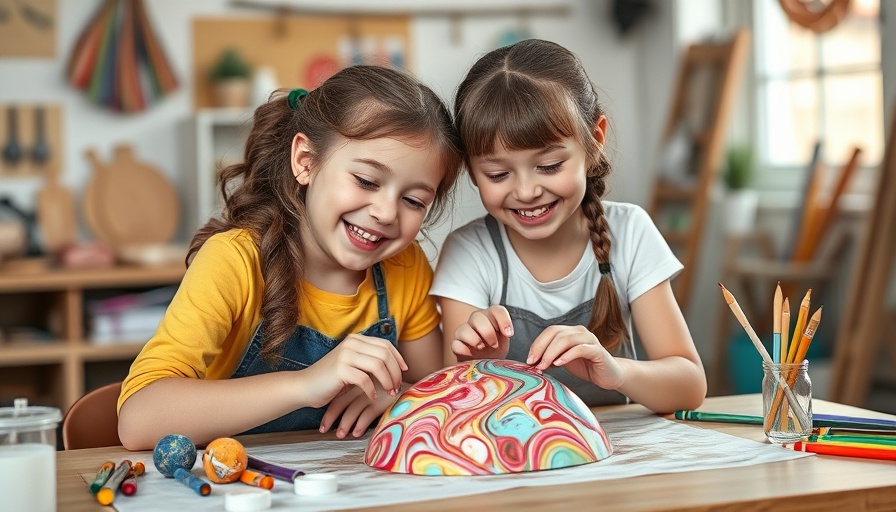
What Is Mindful Marble Art?
Mindful marble art is more than just a fun creative task; it is a unique opportunity for children of all ages to engage with their senses in a purposeful way. This artistic practice combines the joy of painting with the principles of mindfulness, allowing youngsters to explore colors, textures, and movements while enhancing their ability to focus and express themselves. By using rolling marbles or similar objects in paint, children can create mesmerizing patterns while being fully present in the moment.
Why Engage in Mindful Marble Art?
This artistic technique offers a variety of benefits that extend beyond just the visual appeal of the finished product. By nurturing patience and emotional regulation, mindful marble art can cultivate critical life skills in children. As they learn to control their movements and focus their thoughts, they simultaneously strengthen their breath-body connection, which can be particularly valuable in navigating everyday challenges, both big and small.
Essential Materials for Your Mindful Journey
To embark on this creative adventure, gather a shallow tray or box, a sheet of paper, non-toxic paint, and marbles or other rolling objects. These simple materials transform into a gateway for sensory exploration. By setting an inviting atmosphere and encouraging meaningful interactions, you can elevate the entire experience, fostering a deeper connection between you and your child.
A Step-by-Step Guide to Mindful Marble Art
1. Set the Space: Creating a calm environment starts the process on a positive note. Sit together, breathe intentionally, and ask your child how they feel in that moment. Establishing a mindful focus will set the stage for the creativity that lies ahead.
2. Sensory Preparation: Before diving into painting, allow your child to explore the marbles. Ask them to describe the sensations they experience—smoothness, temperature, and weight are all key points of exploration that heighten their awareness. What about the paint? Is it sticky or slippery? This step builds anticipation and excitement for the creative process.
3. Rolling with Awareness: Encourage your child to gently place the marbles in the paint, guiding them to tilt the tray as they breathe in and out. Engaging with their breath adds a meditative quality to the experience. Ask questions to keep them engaged: What happens when they change the speed at which they tilt the tray? This continuous inquiry not only stimulates curiosity but also strengthens their problem-solving skills.
4. Reflect and Appreciate: Once the art is completed, take time to admire the unique patterns created together. Reflect on the feelings evoked during the activity and express gratitude for the moment spent creating. This closing ritual reinforces emotional connection and promotes positive memories associated with both the art and their creativity.
Emotional and Human Interest Angles
Mindful marble art can be a delightful bonding experience, not just a mere artistic endeavor. The laughter that echoes through the room and the shared expressions of wonder help forge deeper connections between children and adults. This activity can provide a meaningful respite from the hustle of daily life, especially in an age where fast-paced routines can often overshadow genuine connections.
Tools, Techniques, and Resources
While the main materials required are simple and accessible, consider incorporating additional sensory elements such as scented paints or smooth textured papers, which can enhance the experience. Encourage kids to explore other art mediums and fuse mindful techniques into various activities. For families wanting to explore mindfulness further, resources such as workshops or local classes on mindfulness practices can also provide additional support.
Moving Forward with Mindful Creativity
Mindful marble art presents a valuable opportunity for families to connect meaningfully and learn more about their own emotions and creativity. When practiced regularly, this sensory-rich activity can enhance children's mental health and emotional well-being, preparing them for life’s various challenges. Whether you’re a parent, teacher, or mentor, consider incorporating this vibrant practice into your daily routine to foster a new layer of creativity and mindfulness.
Join the Mindful Movement!
Don't miss the chance to explore the benefits of mindful marble art with your family. Embrace creativity, connection, and the joy of being present in the moment. Find a quiet spot, gather your materials, and step away from screens to let your imagination flow. Start your mindful art adventure today and create beautiful memories that last a lifetime!
 Add Row
Add Row  Add
Add 




Write A Comment